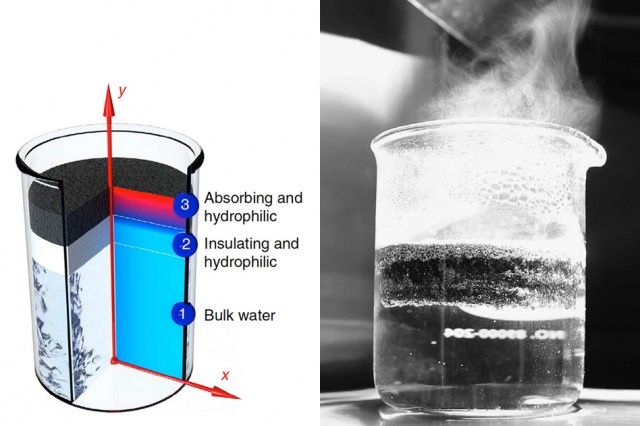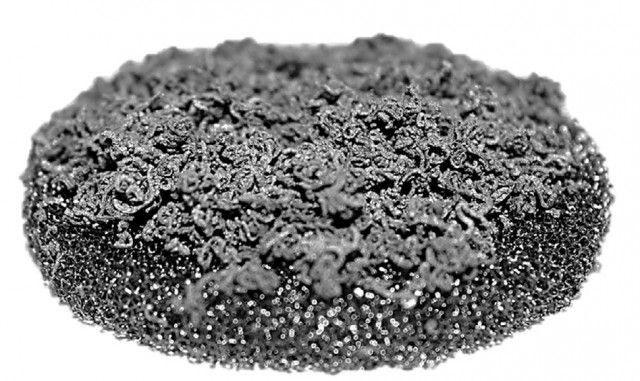
A team of scientists from MIT have published an article in Nature Communications, entitled Solar steam generation by heat localization, that may open up new opportunities for inexpensive small scale, low temperature production of steam. Holy smokes folks, (or at least moister laden aerosols), hold on to your shorts and sit down because this development is more than just a lot of hot air! The scientific abstract in Nature is dense so lets start with Sebastian Anthony reporting in Extreme Tech that MIT creates graphite ‘solar sponge’ that converts sunlight into steam with 85% efficiency.
MIT is reporting that it has created a new, cheap material — using a microwave, no less — that converts sunlight into steam with an amazing 85% efficiency. This could have major repercussions in the realms of desalination and sterilization, and perhaps for concentrated solar thermal power generation as well.The new material, developed by MIT mechanical engineer Hadi Ghasemi, consists of a thin double-layered disc. The bottom layer consists of spongy carbon foam that doubles up as a flotation device and a thermal insulator that prevents solar energy from dissipating into the fluid underneath. The top layer — the active layer — consists of flakes of graphite that were exfoliated using a microwave. The microwave causes the graphite to bubble up “just like popcorn” according to Gang Chen, another researcher involved with the work. [doi:10.1038/ncomms5449 - "Solar steam generation by heat localization"]
When sunlight hits the graphite, hot spots are created that draw water up through the carbon foam via capillary action. When the water reaches the hot spots in the graphite, there’s enough heat to turn the water into steam. ... The low solar intensity requirement (10x is easy to obtain with a simple lens or reflector) means this could a very good way of producing clean water or sterilizing equipment (to this day, steam is still a very popular way of sterilizing things). Bulk desalination is another possibility, though we wonder if the carbon foam wouldn’t get clogged up with the leftover salt crystals.
 Photocredits for this and above :http://www.nature.com/ncomms/2014/140721/ncomms5449/full/ncomms5449.html
Photocredits for this and above :http://www.nature.com/ncomms/2014/140721/ncomms5449/full/ncomms5449.htmlSebastian Anthony's concerns about limescale and corrosion are valid if such a method were used to achieve desalinization by directly boiling off ocean water through the carbon sponge, however, wouldn't it be more clever to use the carbon sponge as an solar energy generating device which then powered a traditional desalinization process?
In the carbon sponge solar power device we could use only the purest distilled water, perhaps combined with some chemicals to lower viscosity, and include some kind of regular back flow cleaning cycle if necessary to keep the carbon sponge clean and at peak efficiency.
Imagine if we instead of $3 billion a year for weapons for Israel we could instead help both Israel and Palestine, and all other desert areas have extremely low cost energy and abundant sources of water. My understanding is that much of the conflict is really about control of the areas in the West Bank with water access.
Could this possibly be a technological breakthrough for an otherwise intractable political deadlock?
As always with new inventions we must recognize that the delays between even ultimately successful commercial innovations can often be measured in decades. So far all scientist have done is say "hey look, we've discovered a new way to make steam real cheaply!" Still don't you also get a thrill and "quivers in special places" when technological "breakthroughs" can tantalize our imaginations like this?
For those of you who like more succinct descriptions right from the horses' mouths, here is the abstract in Nature Communication by Hadi Ghasemi, George Ni, Amy Marie Marconnet, James Loomis, Selcuk Yerci, Nenad Miljkovic & Gang Chen
Yes, I can hear many of you, even from here, saying, "why didn't you just say so in the first place?" Because I'm used to getting paid by the word, that's why! And if I fall out practice posting succinct stuff here for free I may have to cut back on the lifestyle to which I've become accustomed to in the highly paid world of social blogging!
Currently, steam generation using solar energy is based on heating bulk liquid to high temperatures. This approach requires either costly high optical concentrations leading to heat loss by the hot bulk liquid and heated surfaces or vacuum. New solar receiver concepts such as porous volumetric receivers or nanofluids have been proposed to decrease these losses. Here we report development of an approach and corresponding material structure for solar steam generation while maintaining low optical concentration and keeping the bulk liquid at low temperature with no vacuum. We achieve solar thermal efficiency up to 85% at only 10 kW m−2. This high performance results from four structure characteristics: absorbing in the solar spectrum, thermally insulating, hydrophilic and interconnected pores. The structure concentrates thermal energy and fluid flow where needed for phase change and minimizes dissipated energy. This new structure provides a novel approach to harvesting solar energy for a broad range of phase-change applications.
I love you all but sometime imagining what you folks could be thinking really gets me "steamed up." So pleeeze [sic] ... just chill out and give me a break. Take a chillaxative or something and put your shorts back on.
This is pretty cool hot scientific research and I just read an article I'm going to post in tomorrow's Science of the Future edition that reading and thinking about articles like this can boost your "brain neurotropic development factor," BNDF, which is the key neuro-chemical catalized that can restore and even grow new neurons and brain cells even in older folks, especially if you exercise. (Well actually they only mentioned the exercise part, but if you exercised as much as I do, I suspect you would have so much surplus BNDF that the rest of my claims about boosting your BNDF just from reading my articles might seem obvious and not just a lot to hot air.) Doesn't reading about fancy brain chemicals just blow you mind?
And, admit it, don't you feel smarter already? How much more scientific proof do we need, folks?
Woof, woof, aaaaawwwwwwwhhhhhuuuuu!
 When you're hot, you're hot.
When you're hot, you're hot.